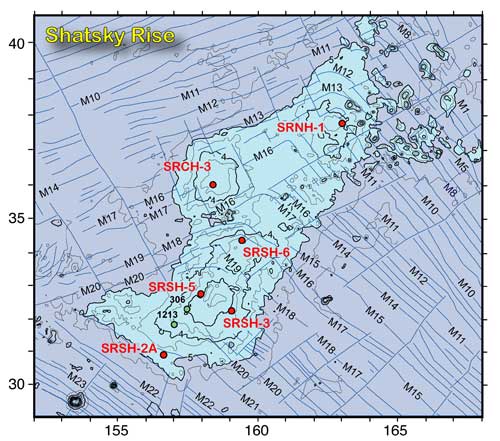Integrated Ocean Drilling
Program Schedules Shatsky Rise Expedition
for 2009
In its newly
published schedule for 2009,
the Integrated Ocean Drilling Program has scheduled
an expedition to core Shatsky Rise, a large oceanic
plateau in the northwestern Pacific. The expedition
objective is to drill and core a total of ~1 km of
igneous rock from 6 sites on the plateau to determine
the age, magmatic source, and evolution of this plateau
and to test hypotheses of plume and plate origins for
oceanic plateaus.
The preliminary schedule for
the expedition is 4 September - 4 November, 2009. Applications
to sail as a scientist on board this expedition are
being accepted until 9 January 2009. Information
about the drilling cruise, including the proposal from
which the expedition is being developed, can be found
at the IODP
Shatsky Rise webpage, and links therein.

Proposed drill sites superimposed
on bathymetry and magnetic lineation map. Red
dots show proposed coring sites. Green symbols
denote two DSDP and ODP sites. Bathymetric
contours shown at 500-m intervals with depths shallower
than 5000 m in light blue.
Proposal 654-Rev2 Abstract
Testing Plume and Plate Models
of Ocean Plateau Formation at Shatsky Rise, Northwest
Pacific Ocean
One of the most fundamental questions
of modern geodynamics is the process of mantle convection
and its impact on the Earth’s surface through
volcanism. The greatest source of non-ocean-ridge volcanism
appears to be massive eruptive episodes that formed
oceanic plateaus, volcanic passive margins, and continental
flood basalts. A widely accepted hypothesis for
such volcanism is that it results from the head of
a starting plume, which rises from the deep mantle,
spreads out beneath the lithosphere, and melts cataclysmically
in a massive outpouring of volcanic activity.
Despite
the wide acceptance of this hypothesis, a convincing
case for a plume head origin has not been made for
any plateau; rather, significant complexities have
been revealed by recent drilling of the Kerguelen and
Ontong Java plateaus. Indeed, non-plume explanations
for non-ridge oceanic volcanism recently have gained
favor among some workers, and the very existence of
mantle plumes has been questioned.
One great
difficulty with research to date is that the original
setting, relative to mid-ocean ridges and plate tectonics,
is poorly known for most plateaus because they were
formed during the mid-Cretaceous when no magnetic reversals
formed ridge-parallel anomalies to record ridge locations.
Shatsky Rise, located 1500 km east of Japan, is unique
in being the only large oceanic plateau formed during
a time of magnetic reversals, permitting its tectonic
setting to be resolved. Magnetic lineations show
that the plateau formed along the trace of a triple
junction, intimately related to ridge tectonics.
Existing
data demonstrate that several aspects of Shatsky Rise’s
history (e.g., massive, rapid initial growth,
transition from large to small magma flux, capture
of ridges) fit the plume head model. On the other hand,
the coincidence of volcanism with the triple junction,
ridge jumps, and the lack of isotopic evidence for
a hotspot-type mantle source can all be taken as favoring
a plate-controlled origin.
Its unique combination
of features makes Shatsky Rise the best location on
Earth to test plume versus plate-tectonic hypotheses
of ocean plateau formation. We propose a single
leg on the non-riser drill ship to core ~1000 m of
igneous basement at 6 sites on Shatsky Rise to examine
the history, source(s), and evolution of this plateau.
From the results, we hope to be able to put to rest
the question of whether oceanic plateaus like Shatsky
Rise were formed from deep-sourced mantle plumes or
interaction of plate boundaries and the lithosphere
with the shallow mantle.
For more information, contact
Will Sager, co-chief scientist at wwsager@uh.edu
last updated 31st October, 2008 |
